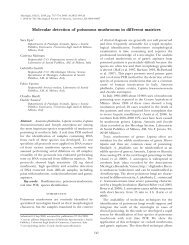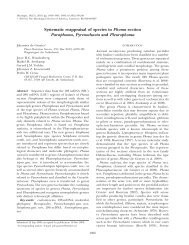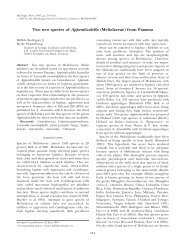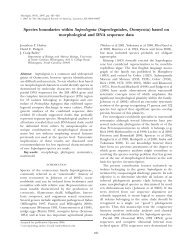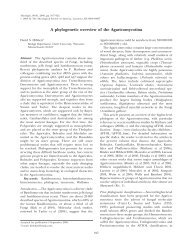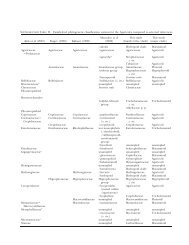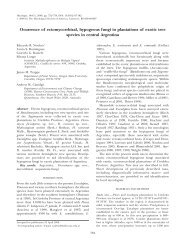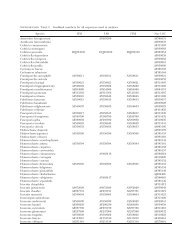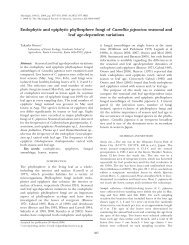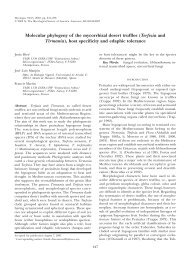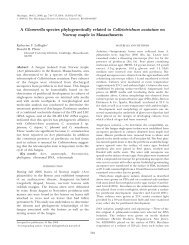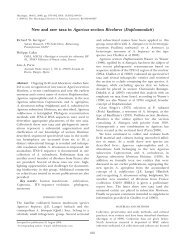Description of Gibberella sacchari and neotypification of ... - Mycologia
Description of Gibberella sacchari and neotypification of ... - Mycologia
Description of Gibberella sacchari and neotypification of ... - Mycologia
Create successful ePaper yourself
Turn your PDF publications into a flip-book with our unique Google optimized e-Paper software.
<strong>Mycologia</strong>, 97(3), 2005, pp. 718–724.<br />
2005 by The Mycological Society <strong>of</strong> America, Lawrence, KS 66044-8897<br />
<strong>Description</strong> <strong>of</strong> <strong>Gibberella</strong> <strong>sacchari</strong> <strong>and</strong> <strong>neotypification</strong> <strong>of</strong> its anamorph<br />
Fusarium <strong>sacchari</strong><br />
John F. Leslie 1<br />
Department <strong>of</strong> Plant Pathology, Throckmorton Plant<br />
Sciences Center, Kansas State University, Manhattan,<br />
Kansas 66506-5502<br />
Brett A. Summerell<br />
Suzanne Bullock<br />
Royal Botanic Gardens <strong>and</strong> Domain Trust, Mrs.<br />
Macquaries Road, Sydney, New South Wales 2000,<br />
Australia<br />
Frank J. Doe<br />
Department <strong>of</strong> Biology, University <strong>of</strong> Dallas, Irving,<br />
Texas 75061<br />
Abstract: We described the teleomorph <strong>of</strong> Fusarium<br />
<strong>sacchari</strong> as <strong>Gibberella</strong> <strong>sacchari</strong>, sp. nov. This species<br />
can be separated from other species <strong>of</strong> <strong>Gibberella</strong> on<br />
the basis <strong>of</strong> the longer, narrower ascospores found in<br />
G. <strong>sacchari</strong> <strong>and</strong> by sexual cross fertility. Female-fertile<br />
mating type tester strains were developed that can be<br />
used for making sexual crosses with this heterothallic<br />
fungus under laboratory conditions. The anamorph,<br />
Fusarium <strong>sacchari</strong>, was neotypified.<br />
Key words: biological species, Fusarium neoceras,<br />
Fusarium subglutinans sensu lato, <strong>Gibberella</strong> fujikuroi<br />
mating population B, maize, sorghum, sugarcane<br />
INTRODUCTION<br />
Nine mating populations or biological species, denoted<br />
by the letters A–I, have been identified within<br />
the <strong>Gibberella</strong> fujikuroi species complex (Britz et al<br />
2002, Samuels et al 2001, Zeller et al 2003). The anamorphs<br />
<strong>of</strong> all nine have unique Latin binomials as<br />
do eight <strong>of</strong> the nine teleomorphs. Our objective in<br />
this report is to provide a name <strong>and</strong> formal description<br />
for the teleomorph <strong>of</strong> the ninth biological species<br />
<strong>and</strong> to describe the mating-type tester strains that<br />
are commonly used for identification purposes. To<br />
clarify the nomenclature <strong>and</strong> taxonomy <strong>of</strong> this taxon<br />
we neotypify the anamorph, Fusarium <strong>sacchari</strong>.<br />
Accepted for publication 6 Jan 2005.<br />
1 Corresponding author. Department <strong>of</strong> Plant Pathology, 4002<br />
Throckmorton Plant Sciences Center, Kansas State University, Manhattan,<br />
Kansas 66506-5502; Phone: 785-532-1363; Fax: 785-532-<br />
2414; E-mail: jfl@plantpath.ksu.edu<br />
718<br />
MATERIALS AND METHODS<br />
Cultures <strong>and</strong> culturing conditions.—Cultures examined were<br />
recovered from sugarcane <strong>and</strong> sorghum <strong>and</strong> either provided<br />
to us or collected by us as indicated in the list below.<br />
Strain numbers from other collections are given where<br />
known, <strong>and</strong> are: ATCC—American Type Culture Collection,<br />
Manassas, Virginia; BBA—Biologische Bundesanstalt für<br />
L<strong>and</strong>- und Forstwirtschaft, Berlin, Germany; FGSC—Fungal<br />
Genetics Stock Center, University <strong>of</strong> Missouri-Kansas City,<br />
Kansas City, Missouri; FRC—Pennsylvania State University,<br />
University Park, Pennsylvania; SNS—University <strong>of</strong> California,<br />
Davis, California; KSU—Kansas State University, Manhattan,<br />
Kansas; PTS—University <strong>of</strong> California, Berkeley, California.<br />
FGSC <strong>and</strong> KSU numbers are used preferentially.<br />
When isolates were recovered from plant material, they<br />
were plated onto semiselective peptone-PCNB media (Nash<br />
<strong>and</strong> Snyder 1962). After 4–7 d incubation at 25 C, we selected<br />
Fusarium colonies that emerged from this material.<br />
We purified all cultures, including those received from other<br />
investigators, by subculturing single conidia separated by<br />
micromanipulation. Isolates were cultured routinely on carnation<br />
leaf agar (CLA) (Fisher et al 1982), or on modified<br />
Czapek’s complete medium (Correll et al 1987).<br />
All strains are maintained as spore suspensions in 15%<br />
glycerol at 70 C. We have deposited a dried culture <strong>of</strong><br />
FGSC 7610 FGSC 7611, representing G. <strong>sacchari</strong> with the<br />
National Fungus Collection, Beltsville, Maryl<strong>and</strong>, as BPI<br />
843974. Female-fertile mating-type tester strains (strain<br />
numbers KSU B-03853 [ FGSC 7611] <strong>and</strong> KSU B-03852<br />
[ FGSC 7610]) were deposited as isotypes with the Fungal<br />
Genetics Stock Center.<br />
We used this st<strong>and</strong>ard <strong>Gibberella</strong> fujikuroi mating population<br />
mating-type tester strains in all mating tests (G. fujikuroi<br />
mating population, <strong>Gibberella</strong> teleomorph, FGSC strain<br />
numbers <strong>and</strong> mating types): G. fujikuroi mating population<br />
A, <strong>Gibberella</strong> moniliformis, FGSC 7600 (MATA-1), FGSC<br />
7603 (MATA-2); G. fujikuroi mating population B, <strong>Gibberella</strong><br />
<strong>sacchari</strong>, FGSC 7611 (MATB-1), FGSC 7610 (MATB-2);<br />
G. fujikuroi mating population C, <strong>Gibberella</strong> fujikuroi, FGSC<br />
8931 (MATC-1), FGSC 8932 (MATC-2); G. fujikuroi mating<br />
population D, <strong>Gibberella</strong> intermedia, FGSC 7615 (MATD-1),<br />
FGSC 7614 (MATD-2); G. fujikuroi mating population E,<br />
<strong>Gibberella</strong> subglutinans, FGSC 7616 (MATE-1), FGSC 7617<br />
(MATE-2); G. fujikuroi mating population F, <strong>Gibberella</strong> thapsina,<br />
FGSC 7057 (MATF-1), FGSC 7056 (MATF-2); G. fujikuroi<br />
mating population G, <strong>Gibberella</strong> nygamai, FGSC 8934<br />
(MATG-1), FGSC 8933 (MATG-2); G. fujikuroi mating population<br />
H, <strong>Gibberella</strong> circinata, FGSC 9022 (MATH-1), FGSC<br />
9023 (MATH-2); G. fujikuroi mating population I, <strong>Gibberella</strong><br />
konza, FGSC 8910 (MATI-1), <strong>and</strong> FGSC 8911 (MATI-2).
Microscopy.—The description <strong>of</strong> <strong>Gibberella</strong> <strong>sacchari</strong> is based<br />
on crosses (FGSC 7610 FGSC 7611) produced on carrot<br />
agar. Perithecia were treated with 3% KOH <strong>and</strong> 100% lactic<br />
acid to observe any color reaction, <strong>and</strong> measured in situ.<br />
Asci <strong>and</strong> ascospores were mounted in water for measurement<br />
<strong>and</strong> photography. Measurements were taken <strong>of</strong> 20<br />
each <strong>of</strong> perithecia, asci <strong>and</strong> ascospores. Whole perithecia<br />
were fixed in 6.5% glutaraldehyde in 100 mM sodium cacodylate<br />
buffer at pH 7.6 for 4 h at room temperature (Bullock<br />
et al 1980), dehydrated in a graded ethanol series <strong>and</strong><br />
infiltrated <strong>and</strong> embedded in LR White resin. Sections 1.5<br />
m thick were cut with a Reichert ultramicrotome, dried<br />
onto poly-L-lysine-coated glass slides <strong>and</strong> stained with 0.5%<br />
toluidine blue O for 10 s (Feder <strong>and</strong> O’Brien 1968). Sections<br />
were mounted in immersion oil. Morphological features<br />
<strong>of</strong> the anamorph (F. <strong>sacchari</strong>) were photographed in<br />
situ on carnation leaf agar. Macro- <strong>and</strong> microconidia were<br />
mounted in water on glass slides <strong>and</strong> photographed with<br />
DIC optics.<br />
Mating-type specific PCR <strong>and</strong> crossing procedures.—We identified<br />
mating-type idiomorphs (MAT-1 or MAT-2) for the F.<br />
<strong>sacchari</strong> isolates with PCR-based assays, as described in either<br />
Kerényi et al (1999) or Steenkamp et al (2000), <strong>and</strong><br />
in crosses to the female-fertile tester isolates (FGSC 7610<br />
MAT-2 or FGSC 7611 MAT-1) developed as a part <strong>of</strong> this<br />
study. We made crosses on carrot agar as described in Klittich<br />
<strong>and</strong> Leslie (1988).<br />
RESULTS<br />
The initial mating-type testers used for this species<br />
were the field isolates FGSC 7608 <strong>and</strong> FGSC 7609.<br />
These strains are both highly fertile but are subject<br />
to strain degeneration, in which a tough, dense, mycelium<br />
with fingerlike projections is produced, with<br />
a thinner, wispier mycelium between the denser mycelial<br />
fingers. If these colonies are subcultured, then<br />
the amount <strong>of</strong> dense mycelia continues to increase<br />
at the expense <strong>of</strong> the thinner mycelium. The thinner<br />
mycelium eventually disappears <strong>and</strong> only the denser<br />
mycelium can be found. Spores from such colonies<br />
have an apparently normal ability to serve as a male<br />
parent in a sexual cross. When used as a female parent,<br />
however, the only portion <strong>of</strong> the colony on which<br />
perithecia form is that with the thinner mycelium.<br />
Once the strain produces only the denser mycelium,<br />
the colony no longer is useable as a female parent.<br />
The frequency with which the dense sectors appear<br />
is irregular, but once the process has begun we have<br />
not been able to recover a colony that has only the<br />
thin phenotype. Instead we begin a new culture from<br />
the frozen stock <strong>and</strong> discard the degenerating culture.<br />
We crossed FGSC 7608 <strong>and</strong> FGSC 7609 <strong>and</strong> collected<br />
78 r<strong>and</strong>om ascospore progeny. We used these<br />
progeny as the female parents in crosses with the pa-<br />
LESLIE ET AL: DESCRIPTION OF G. SACCHARI<br />
719<br />
rental strains <strong>and</strong> identified strains that repeatedly<br />
produced, at least qualitatively, a large number <strong>of</strong> mature<br />
perithecia. Mating type in all <strong>of</strong> the progeny was<br />
identified on the basis <strong>of</strong> these crosses. We also identified<br />
progeny that retained exclusively the thin phenotype<br />
<strong>and</strong> did not produce sectors with the dense<br />
mycelial phenotype in at least three successive subcultures.<br />
We selected two progeny (FGSC 7610 <strong>and</strong><br />
FGSC 7611) based on these criteria <strong>and</strong> have been<br />
using them as the st<strong>and</strong>ard testers for this mating<br />
population since 1990. We have never seen these testers<br />
develop the dense, female-sterile mycelial sectors<br />
that can occur in their parents <strong>and</strong> have not noticed<br />
any appreciable reduction in female fertility <strong>of</strong> these<br />
strains over this time.<br />
Members <strong>of</strong> the B mating population are distinct<br />
from other mating populations in the G. fujikuroi<br />
species complex in that they do not cross with the<br />
testers from any <strong>of</strong> the other eight described mating<br />
populations. Strains listed are cross-fertile with either<br />
FGSC 7610 or FGSC 7611 but not with testers for the<br />
other known biological species in the G. fujikuroi species<br />
complex. In most cases no perithecia are made<br />
in the crosses between strains from the different mating<br />
populations. On rare occasions a few perithecia<br />
may be produced, presumably due to homothallism<br />
such as that observed with these testers <strong>and</strong> a few<br />
other strains <strong>of</strong> mating population B (Britz et al<br />
1999). Thus any crosses in which only a few perithecia<br />
are produced on a plate must be viewed as suspect<br />
until the progeny produced are shown to have a biparental<br />
origin.<br />
TAXONOMY<br />
<strong>Gibberella</strong> <strong>sacchari</strong> Summerell et Leslie sp. nov.<br />
FIGS. 1–7<br />
Perithecia superficialia, livida, 270–390 m alta, 250–390<br />
m diam. Asci fusiformes, dehiscentes, octospori. Ascosporae<br />
exudatae in cirrhis, laeves, hyalinae, ellipsoideae vel<br />
obovoideae, 0–1 septatae, plerumque 1-septatae et ad septum<br />
leviter constrictae, 3–4.5 7.0–8.0 m. Anamorphosis:<br />
Fusarium <strong>sacchari</strong> (E.J. Butler) W. Gams.<br />
HOLOTY PUS. Cultura exsiccata in agaro ex FGSC 7610<br />
FGSC 7611.<br />
Etymology.—Taken from the anamorph, referring to<br />
the original host plant, sugarcane.<br />
Teleomorph.—Perithecia superficial, solitary to aggregated<br />
in groups <strong>of</strong> a few <strong>and</strong> seated on a minute<br />
stromatic base, obovoidal <strong>and</strong> warty (FIGS. 1–2); 270–<br />
390 (mean 325) m, 250–390 (mean 310) m<br />
diam; blue-black, color not changing in 3% KOH,<br />
turning red in 100% lactic acid. Perithecial wall 23–<br />
39 (mean 30.6) m thick laterally, formed <strong>of</strong> two
720 MYCOLOGIA<br />
FIGS. 1–7. <strong>Gibberella</strong> <strong>sacchari</strong>, characteristics <strong>of</strong> perithecia, asci <strong>and</strong> ascospores produced from a cross <strong>of</strong> strains FGSC<br />
7610 FGSC 7611 on carrot agar. 1–2. Perithecia. 3. Transverse section <strong>of</strong> a perithecium stained with toluidine blue O. 4.<br />
Detail <strong>of</strong> transverse section <strong>of</strong> perithecial wall. 5–6. Asci. 7. Ascospores. Bars: 1 <strong>and</strong> 2 200 m; 3 <strong>and</strong> 5 50 m; 4, 6 <strong>and</strong><br />
7 25 m.<br />
obvious regions (FIGS. 3–4). Outer wall region 18–33<br />
(mean 25.6) m thick; outer cells angular to<br />
elliptic in transverse section, 5.3–12 (mean 8.4)<br />
m length 3.1–5.9 (mean 4.3) m thick, with<br />
the largest cells at the exterior <strong>and</strong> the smallest cells<br />
toward the interior <strong>of</strong> the wall, walls <strong>of</strong> cells 0.5–1.2<br />
(mean 0.9) m thick <strong>and</strong> pigmented. Inner wall<br />
region 4.0–5.9 (mean 4.9) m thick; cells angular<br />
to elliptic, 7.2–16 (mean 10.6) m length <br />
1.1–3.2 (mean 2.2) m thick. Inner wall cells fu-
siform, thin-walled <strong>and</strong> irregular, walls <strong>of</strong> inner cells<br />
0.3–0.6 (mean 0.4) m thick <strong>and</strong> pigmented (FIG.<br />
4). Outer <strong>and</strong> the inner wall regions merging imperceptibly;<br />
cells <strong>of</strong> the outer region more pigmented.<br />
Perithecial apex continuous with the outer <strong>and</strong> inner<br />
wall layers; cells at the apex smaller appearing as a<br />
reticulum; cells forming the ostiolar opening clavate<br />
<strong>and</strong> thick-walled at the cell tips; nonpigmented<br />
merging periphyses. Cells <strong>of</strong> the apex attaining the<br />
same length to form an apical disk.<br />
Asci fusiform (FIGS. 5–6), regularly dehiscing during<br />
slide preparation <strong>and</strong> 8-spored. Ascospores exuded<br />
in a cirrus (FIGS. 1–2), ellipsoidal to obovoid<br />
with both ends rounded, 0–1-septate <strong>and</strong> slightly constricted<br />
at the septum, 7.0–8.0 3–4.5 (mean 7.6 <br />
4.2) m (FIGS. 5–7). Heterothallic species, reproductively<br />
isolated from previously described species <strong>of</strong><br />
<strong>Gibberella</strong>.<br />
Isolates examined.—BRAZIL: culture isolated from sorghum<br />
by Shirley Nash Smith <strong>and</strong> received from J. Puhalla <strong>and</strong> P.T.<br />
Spieth 1984, MAT-2, KSU B-00205 (PTS F-1178, SNS<br />
Br19a). CHINA: Taiwan, Hsingying; cultures isolated from<br />
sugarcane plants by Shirley Nash Smith in 1981 <strong>and</strong> received<br />
from J. Puhalla <strong>and</strong> P.T. Spieth 1984, MAT-1, KSU<br />
B-00281 (ATCC 201263, FGSC 7609, FRC M3128, SNS HY-<br />
7, PTS F-1254); MAT-2, KSU B-00278 (ATCC 201262, FGSC<br />
7608, FRC M3127, SNS HY-4, PTS F-1251). EL SALVADOR:<br />
La Libertad; cultures isolated from diseased (stalk rot) sorghum<br />
plants by L.E. Claflin 2002; all MAT-1, KSU B-12751,<br />
KSU B-12752, KSU B-12753, KSU B-12754, KSU B-12755 &<br />
KSU B-12756. GERMANY: from Cattleya <strong>and</strong> received from<br />
H. Nirenberg via P.E. Nelson; MAT-2 KSU B-03828 (FRC<br />
1217, BBA 62260). INDIA: all from sugarcane <strong>and</strong> received<br />
from H. Nirenberg via P.E. Nelson; MAT-1, KSU B-03819<br />
(FRC M941, BBA 63340), KSU B-03820 (FRC M942, BBA<br />
63342); MAT-2, KSU B-03821 (FRC M943, BBA 63448).<br />
MEXICO: Guadalajara; cultures isolated from diseased<br />
(stalk rot) maize plants by L.E. Claflin 2002; MAT-1, KSU<br />
B-12747; MAT-2, KSU B-12748, KSU B-12749 & KSU B-<br />
12750. PHILIPPINES: Pioneer Overseas Corporation Research<br />
Station, Banbic, Calruyao, Laguna; all cultures isolated<br />
by J.F. Leslie 1988; from diseased sorghum leaf, MAT-<br />
1, KSU B-01722 (FRC M5476), KSU B-01724 (FRC M5478),<br />
KSU B-01725 (FRC M5479), KSU B-01726 (FRC M5480);<br />
from diseased sorghum stalk, MAT-2, KSU B-01721 (FRC<br />
M5467); from sorghum seed, MAT-1, KSU B-01730 (FRC<br />
M5484), KSU B-01732 (FRC M5486), KSU B-01735 (FRC<br />
M5489); MAT-2, KSU B-01727 (FRC M5481), KSU B-01728<br />
(FRC M5482). USA: Kansas, Manhattan; cultures recovered<br />
from a laboratory cross <strong>of</strong> FGSC 7608 (KSU B-00278) <strong>and</strong><br />
FGSC 7609 (KSU B-00281) by J.F. Leslie 1989; MAT-1 KSU<br />
B-03853 (ISOTY PE, ATCC 201265, FRC M6866, FGSC<br />
7611); MAT-2 KSU B-03852 (ISOTY PE, ATCC 201264, FRC<br />
M6865, FGSC 7610).<br />
NEOTY PIFICATION OF FUSARIUM SACCHARI<br />
Fusarium <strong>sacchari</strong> (E.J. Butler) W. Gams first was described<br />
as Cephalosporium <strong>sacchari</strong> Butler from sug-<br />
LESLIE ET AL: DESCRIPTION OF G. SACCHARI<br />
721<br />
arcane in India in 1913 (Butler <strong>and</strong> Khan 1913) but<br />
did not include a description <strong>of</strong> macroconidia. Cultures<br />
with macroconidia were described by Wollenweber<br />
<strong>and</strong> Reinking (1925) as Fusarium neoceras Wollenweber<br />
& Reinking. Gams (1971) synonymized the<br />
two names to the present form. Because the original<br />
type specimen no longer is available we have chosen<br />
isolate KSU B-03852 (ATCC 201264, FGSC 7610, FRC<br />
M6865) to neotypify the anamorph. Because this isolate<br />
is a single ascospore isolate from two parents isolated<br />
from sugarcane, has been shown to be conspecific<br />
with isolates KSU B-03819 (FRC M941, BBA<br />
63340), KSU B-03820 (FRC M942, BBA 63342); KSU<br />
B-03821 (FRC M943, BBA 63448) from sugarcane in<br />
India by sequencing <strong>and</strong> AFLPs (data not shown)<br />
<strong>and</strong> is one <strong>of</strong> the two parental strains used to create<br />
the teleomorph we have chosen it to neotypify.<br />
Neotype, designated here Fusarium <strong>sacchari</strong> (E.J.<br />
Butler) W. Gams. KSU B-03852 (ATCC 201264, FRC<br />
M6865, FGSC 7610). A dried culture <strong>of</strong> this strain is<br />
deposited as DAR 76835 at the Plant Pathology Herbarium,<br />
Orange Agricultural Institute, Department<br />
<strong>of</strong> Primary Industries, New South Wales, Australia.<br />
Anamorph features (FIGS. 8–13) are similar to<br />
those described by Nirenberg (1976) <strong>and</strong> Gerlach<br />
<strong>and</strong> Nirenberg (1982). Key features are 3–4-septate<br />
macroconidia (FIGS. 8–9) <strong>and</strong> oval microconidia<br />
(FIGS. 10–11) borne in false heads on monophialides<br />
<strong>and</strong> polyphialides (FIGS. 12–13).<br />
DISCUSSION<br />
Fusarium <strong>sacchari</strong> (E.J. Butler) W. Gams first was described<br />
as Cephalosporium <strong>sacchari</strong> Butler from sugarcane<br />
in India (Butler <strong>and</strong> Khan 1913). The original<br />
description did not include a description <strong>of</strong> macroconidia,<br />
which is not surprising given the scarcity <strong>of</strong><br />
macroconidia formed by this species in in vitro culture.<br />
Wollenweber <strong>and</strong> Reinking (1925) described<br />
cultures with macroconidia as Fusarium neoceras Wollenweber<br />
& Reinking. Gams (1971) synonymized the<br />
two names to the present form. Kuhlman (1982) described<br />
four varieties <strong>of</strong> G. fujikuroi—moniliformis,<br />
subglutinans, fujikuroi <strong>and</strong> intermedia. He used the<br />
name G. fujikuroi var. subglutinans for the teleomorph<br />
<strong>of</strong> F. <strong>sacchari</strong> because these strains at that time<br />
were identified as F. subglutinans. The name <strong>Gibberella</strong><br />
subglutinans now is associated with the former<br />
<strong>Gibberella</strong> fujikuroi mating population E (Samuels et<br />
al 2001), which reflects its initial usage for a fungal<br />
pathogen <strong>of</strong> maize (Edwards 1935). Thus we selected<br />
<strong>sacchari</strong> as the species epithet to maintain similarity<br />
between the anamorphic <strong>and</strong> teleomorphic names.<br />
Relative to other <strong>Gibberella</strong> species, the ascospores<br />
<strong>of</strong> G. <strong>sacchari</strong> are large. In this study the sizes that
722 MYCOLOGIA<br />
FIGS. 8–13. Characteristics <strong>of</strong> Fusarium <strong>sacchari</strong>. 8–9. Macroconidia. 10–11. Oval to obovoid microconidia. 12–13. Microconidia<br />
on monophialides <strong>and</strong> polyphialides produced in carnation leaf agar cultures. Bars 25 m.<br />
we measured were 28–32 3.0–4.5 (mean 30.4 <br />
4.2) m, which is somewhat shorter <strong>and</strong> narrower<br />
than the values observed by Kuhlman (1982) (16–32<br />
4–8 [mean 22.4 5.6] m) wide. Kuhlman (1982)<br />
found the mean values for the ascospore sizes to be<br />
significantly different from the means for G. moniliformis<br />
(17.5 4.8 m), G. fujikuroi (12.5 4.7 m),<br />
<strong>and</strong> G. intermedia (14.6 4.8 m). Our observations<br />
are consistent with his conclusions. In addition G.<br />
<strong>sacchari</strong> probably can be distinguished from G. nygamai<br />
(13.9 5.3 m), G. subglutinans (19.6 5.9<br />
m), G. thapsina (17.0 6.0 m) <strong>and</strong> G. circinata<br />
(12.7 5.2 m) on the basis <strong>of</strong> the generally longer<br />
<strong>and</strong> narrower ascospores found in G. <strong>sacchari</strong>. This<br />
trait could be especially useful for distinguishing G.<br />
<strong>sacchari</strong> from other species in Fusarium subglutinans<br />
sensu lato, which generally are similar morphologically.<br />
With respect to perithecial diameter, the values we<br />
obtained (250–390 m [mean 310 m]) are somewhat<br />
narrower in the range but similar in the mean<br />
(240–420 m [mean 307 m]) to those reported by<br />
Kuhlman (1982). Perithecial diameter could be used<br />
to differentiate perithecia <strong>of</strong> G. <strong>sacchari</strong> from those<br />
<strong>of</strong> G. fujikuroi (mean perithecial diameter 231 m),<br />
G. thapsina (250 m), <strong>and</strong> G. intermedia (389 m)<br />
but not from those <strong>of</strong> G. moniliformis (321 m) or<br />
G. nygamai (309 m) <strong>and</strong> probably not from those<br />
<strong>of</strong> G. subglutinans (336 m) or G. circinata (337 m)<br />
(Klassen <strong>and</strong> Nelson 1996, Klittich et al 1997, Kuhlman<br />
1982). The comparative measurements <strong>of</strong> these<br />
different species must be evaluated with caution however<br />
because the perithecia <strong>and</strong> ascospores they contain<br />
were grown on several different substrates (e.g.<br />
carrot agar, V-8 juice agar <strong>and</strong> carnation leaf agar)<br />
<strong>and</strong> differences in nutrition could alter the values<br />
observed. The degree <strong>of</strong> maturity <strong>of</strong> both the peri-<br />
thecia <strong>and</strong> the spores that they contain similarly<br />
could alter the observed sizes <strong>of</strong> the asci, ascospores<br />
<strong>and</strong> perithecia. Other described Fusarium species to<br />
which F. <strong>sacchari</strong> shows morphological similarity <strong>and</strong><br />
is closely related (e.g. F. acutatum, F. bulbicola, F. concentricum,<br />
F. denticulatum, F. guttiforme, F. pseudocircinatum,<br />
F. pseudonygamai <strong>and</strong> F. ramigenum [Nirenberg<br />
<strong>and</strong> O’Donnell 1998]), have as yet no reported<br />
sexual stage, <strong>and</strong> the utility <strong>of</strong> ascospore size or perithecial<br />
diameter as distinguishing characters for<br />
these species remains unknown.<br />
Representative isolates now assigned to G. <strong>sacchari</strong><br />
<strong>of</strong>ten have been included in studies <strong>of</strong> variation in<br />
physiological traits or molecular characters. Differences<br />
that separate G. <strong>sacchari</strong> from the other members<br />
<strong>of</strong> the G. fujikuroi species complex include sensitivity<br />
to hygromycin <strong>and</strong> benomyl (Yan et al 1993),<br />
polymorphism in isozyme b<strong>and</strong>ing patterns (Huss et<br />
al 1996), chromosome length (Xu et al 1995), AFLP<br />
b<strong>and</strong>ing pattern (Marasas et al 2001) <strong>and</strong> DNA sequences<br />
<strong>of</strong> representative genes (O’Donnell et al<br />
1998). The only unique isozyme b<strong>and</strong> for G. saccahara<br />
is a pattern observed for esterase (Huss et al<br />
1996). However the pattern for glucose-4-phosphate<br />
isomerase is found only in G. moniliformis <strong>and</strong><br />
G. <strong>sacchari</strong> <strong>and</strong> these two species can be distinguished<br />
easily on the basis <strong>of</strong> the pattern for triose<br />
phosphate isomerase, which is unique to G. moniliformis.<br />
O’Donnell et al (1998) concluded that G. <strong>sacchari</strong><br />
was related most closely to F. fujikuroi, F. proliferatum,<br />
F. globosum <strong>and</strong> F. concentricum based on the<br />
sequence <strong>of</strong> the -tubulin, mitochondrial small subunit<br />
rDNA, <strong>and</strong> 28S rDNA genes. Species to which<br />
G. <strong>sacchari</strong> is more similar morphologically (e.g. G.<br />
subglutinans <strong>and</strong> G. circinatum) were not closely related<br />
to G. <strong>sacchari</strong> when these DNA sequences were<br />
used to estimate relatedness. Marasas et al (2001)
showed that G. <strong>sacchari</strong> was distinct from F. <strong>and</strong>iyazi,<br />
F. nygamai, F. pseudocircinatum, F. ramigenum, F. thapsinum<br />
<strong>and</strong> F. verticillioides on the basis <strong>of</strong> AFLP fingerprinting<br />
patterns. Strains <strong>of</strong> G. <strong>sacchari</strong> are not<br />
known to produce fumonisins (Leslie et al 1992).<br />
The strains examined for this study were from Taiwan,<br />
the Philippines, Germany (greenhouse), India,<br />
Mexico <strong>and</strong> El Salvador, but other strains have been<br />
reported from Brazil, India, Malaysia, South Africa<br />
<strong>and</strong> Thail<strong>and</strong> (Leslie 1995). In crosses with the tester<br />
strains, however, many <strong>of</strong> the isolates not included in<br />
this study were reported to produce relatively few<br />
perithecia, <strong>and</strong> thus their identity as G. <strong>sacchari</strong><br />
should be regarded as tentative due to the potential<br />
problems associated with selfing by the testers. The<br />
host range similarly should be considered limited to<br />
maize, sugarcane, orchids <strong>and</strong> sorghum until the isolates<br />
reported from banana, peanut <strong>and</strong> rice have<br />
been examined more closely.<br />
Identification <strong>of</strong> G. <strong>sacchari</strong> can be accomplished<br />
in many ways. The size <strong>of</strong> the ascospores <strong>and</strong> the fertility<br />
<strong>of</strong> the strain in crosses with st<strong>and</strong>ard tester isolates<br />
are the technically simplest means <strong>of</strong> distinguishing<br />
G. <strong>sacchari</strong> from other sibling species in the<br />
former F. subglutinans sensu lato. The species also can<br />
be distinguished based on AFLP patterns, isozymes<br />
<strong>and</strong> by differences in the DNA sequence <strong>of</strong> several<br />
commonly studied genes.<br />
<strong>Gibberella</strong> <strong>sacchari</strong> has yet to be reported under<br />
field conditions, but the anamorph, F. <strong>sacchari</strong>, has<br />
been recovered from a diverse, although small, set <strong>of</strong><br />
host plants. The fungus <strong>of</strong>ten has been associated<br />
with Fusarium sett <strong>and</strong> stem rot <strong>of</strong> sugarcane (Egan<br />
et al 1997); however no comprehensive studies <strong>of</strong><br />
host range or pathogenicity have been conducted.<br />
Given the recent increase in our knowledge <strong>of</strong> the<br />
taxonomy <strong>of</strong> this fungus <strong>and</strong> its close relatives, such<br />
studies would be both interesting <strong>and</strong> important.<br />
ACKNOWLEDGMENTS<br />
This research was supported in part by the Kansas Agricultural<br />
Experiment Station <strong>and</strong> by the Sorghum <strong>and</strong> Millet<br />
Collaborative Research Support Program (INTSORMIL)<br />
AID/DAN-1254-G-00-0021-00 from the U.S. Agency for International<br />
Development. We thank Larry E. Claflin, John<br />
Puhalla, Philip T. Spieth <strong>and</strong> the late Paul E. Nelson for<br />
providing some <strong>of</strong> the strains used in this study. JFL thanks<br />
the Australian-American Fulbright Commission <strong>and</strong> The<br />
Royal Botanic Gardens <strong>and</strong> Domain Trust, Sydney, for the<br />
award <strong>of</strong> fellowships to support his sabbatical leave in Australia.<br />
Contribution No. 03-20-J from the Kansas Agricultural<br />
Experiment Station, Manhattan.<br />
LESLIE ET AL: DESCRIPTION OF G. SACCHARI<br />
LITERATURE CITED<br />
723<br />
Britz H, Coutinho TA, Wingfield MJ, Marasas WFO. 2002.<br />
Emended description <strong>of</strong> <strong>Gibberella</strong> circinata, the cause<br />
<strong>of</strong> pitch canker <strong>of</strong> pines. Sydowia 54:9–22.<br />
, , , , Gordon TA, Leslie JF. 1999.<br />
Fusarium subglutinans f. sp. pini represents a distinct<br />
mating population in the <strong>Gibberella</strong> fujikuroi species<br />
complex. Appl Environ Microbiol 65:1198–1201.<br />
Bullock S, Willetts HJ, Ashford AE. 1980. The structure <strong>and</strong><br />
histochemistry <strong>of</strong> sclerotia <strong>of</strong> Sclerotinia minor Jagger 1.<br />
Light <strong>and</strong> electron microscope studies on sclerotial development.<br />
Protoplasma 104:315–331.<br />
Butler EJ, Khan AH. 1913. Some new sugarcane diseases.<br />
Mem Dept Ag in India, Bot Ser 6:185–190.<br />
Correll JC, Klittich CJR, Leslie JF. 1987. Nitrate non-utilizing<br />
mutants <strong>of</strong> Fusarium oxysporum <strong>and</strong> their use in vegetative<br />
compatibility tests. Phytopathology 77:1640–<br />
1646.<br />
Edwards ET. 1935. Studies on <strong>Gibberella</strong> fujikuroi var. subglutinans<br />
the hitherto undescribed ascigerous stage <strong>of</strong><br />
Fusarium moniliforme var. subglutinans <strong>and</strong> its pathogenicity<br />
on maize in New South Wales. Dept. Agric.<br />
New South Wales Sci Bull 49:1–68.<br />
Egan BT, Magarey RC, Cr<strong>of</strong>t BJ. 1997. Sugarcane. In: Hillocks<br />
RJ, Walker JM, eds. Soilborne diseases <strong>of</strong> tropical<br />
crops. CAB International: Wallingford, Oxon, U.K. p<br />
277–302.<br />
Feder N, O’Brien TP. 1968. Plant microtechnique: some<br />
principles <strong>and</strong> new methods. Am J Bot 55:123–142.<br />
Fisher NL, Burgess LW, Toussoun TA, Nelson PE. 1982. Carnation<br />
leaves as a substrate <strong>and</strong> for preserving cultures<br />
<strong>of</strong> Fusarium species. Phytopathology 72:151–153.<br />
Gams W. 1971. Cephalosporium-artige Schimmelpilze (Hyphomycetes).<br />
Stuttgart, Germany: Gustav Fischer Verlag.<br />
Gerlach W, Nirenberg HI. 1982. The genus Fusarium—a<br />
pictorial atlas. Mitt Bio Bundesanstalt für L<strong>and</strong>- u<br />
Forstw (Berlin-Dahlem) 209:1–406.<br />
Huss MJ, Campbell CL, Jennings DB, Leslie JF. 1996. Isozyme<br />
variation among biological species in the <strong>Gibberella</strong><br />
fujikuroi species complex (Fusarium section Liseola).<br />
Appl Environ Microbiol 62:3750–3756.<br />
Kerényi Z, Zeller KA, Hornok L, Leslie JF. 1999. Molecular<br />
st<strong>and</strong>ardization <strong>of</strong> mating type terminology in the <strong>Gibberella</strong><br />
fujikuroi species complex. Appl Environ Microbiol<br />
65:4071–4076.<br />
Klaasen JA, Nelson PE. 1996. Identification <strong>of</strong> a mating population,<br />
<strong>Gibberella</strong> nygamai sp. nov., within the Fusarium<br />
nygamai anamorph. <strong>Mycologia</strong> 88:965–969.<br />
Klittich CJR, Leslie JF. 1988. Nitrate reduction mutants <strong>of</strong><br />
Fusarium moniliforme (<strong>Gibberella</strong> fujikuroi). Genetics<br />
118:417–423.<br />
, , Nelson PE, Marasas WFO. 1997. Fusarium<br />
thapsinum (<strong>Gibberella</strong> thapsina): a new species in section<br />
Liseola from sorghum. <strong>Mycologia</strong> 89:643–652.<br />
Kuhlman EG. 1982. Varieties <strong>of</strong> <strong>Gibberella</strong> fujikuroi with anamorphs<br />
in Fusarium section Liseola. <strong>Mycologia</strong> 74:<br />
759–768.<br />
Leslie JF. 1995. <strong>Gibberella</strong> fujikuroi: Available populations
724 MYCOLOGIA<br />
<strong>and</strong> variable traits. Can J Bot 73(Supplement 1):S282–<br />
S291.<br />
, Plattner RD, Desjardins AE, Klittich CJR. 1992. Fumonisin<br />
B 1 production by strains from different mating<br />
populations <strong>of</strong> <strong>Gibberella</strong> fujikuroi (Fusarium section<br />
Liseola). Phytopathology 82:341–345.<br />
Marasas WFO, Rheeder JP, Lamprecht SC, Zeller KA, Leslie<br />
JF. 2001. Fusarium <strong>and</strong>iyazi sp. nov., a new species from<br />
sorghum. <strong>Mycologia</strong> 93:1203–1210.<br />
Nash SM, Snyder WC. 1962. Quantitative estimations by<br />
plate counts <strong>of</strong> propagules <strong>of</strong> the bean root rot Fusarium<br />
in field soils. Phytopathology 52:567–572.<br />
Nirenberg HI. 1976. Untersuchungen über die morphologische<br />
und biologische Differenzierung in der Fusarium-Sektion<br />
Liseola. Mitt Biolog Bundesanstalt für<br />
L<strong>and</strong>-u Forstw (Berlin-Dahlem) 169:1–117.<br />
, O’Donnell K. 1998. New Fusarium species <strong>and</strong> combinations<br />
within the G. fujikuroi species complex. <strong>Mycologia</strong><br />
90:434–458.<br />
O’Donnell K, Cigelnik E, Nirenberg HI. 1998. Molecular<br />
systematics <strong>and</strong> phylogeography <strong>of</strong> the <strong>Gibberella</strong> fujikuroi<br />
species complex. <strong>Mycologia</strong> 90:465–493.<br />
Samuels GJ, Nirenberg HI, Seifert KA. 2001. Perithecial spe-<br />
cies <strong>of</strong> Fusarium. In: Summerell BA, Leslie JF, Backhouse<br />
D, Bryden WL, Burgess LW, eds. Fusarium: Paul<br />
E. Nelson memorial symposium. St Paul, Minnesota:<br />
APS Press. p 1–14.<br />
Steenkamp ET, Wingfield BD, Coutinho TA, Zeller KA,<br />
Wingfield MJ, Marasas WFO, Leslie JF. 2000. PCR-based<br />
identification <strong>of</strong> MAT-1 <strong>and</strong> MAT-2 in the <strong>Gibberella</strong><br />
fujikuroi species complex. Appl Environ Microb 66:<br />
4378–4382.<br />
Wollenweber HW, Reinking AO. (1925). Aliquot Fusaria tropicalia,<br />
nova vel revisa. Phytopathology 15:155–169.<br />
Xu J-R, Yan K, Dickman MB, Leslie JF. 1995. Electrophoretic<br />
karyotypes distinguish the biological species <strong>of</strong> <strong>Gibberella</strong><br />
fujikuroi (Fusarium section Liseola). Molec Plant-<br />
Microbe Interact 8:74–84.<br />
Yan K, Dickman MB, Xu J-R, Leslie JF. 1993. Sensitivity <strong>of</strong><br />
field strains <strong>of</strong> <strong>Gibberella</strong> fujikuroi (Fusarium section<br />
Liseola) to benomyl <strong>and</strong> hygromycin B. <strong>Mycologia</strong> 85:<br />
206–213.<br />
Zeller KA, Summerell BA, Bullock S, Leslie JF. 2003. <strong>Gibberella</strong><br />
konza (Fusarium konzum) sp. nov. from prairie<br />
grasses, a new species in the <strong>Gibberella</strong> fujikuroi species<br />
complex. <strong>Mycologia</strong> 95:943–954.



